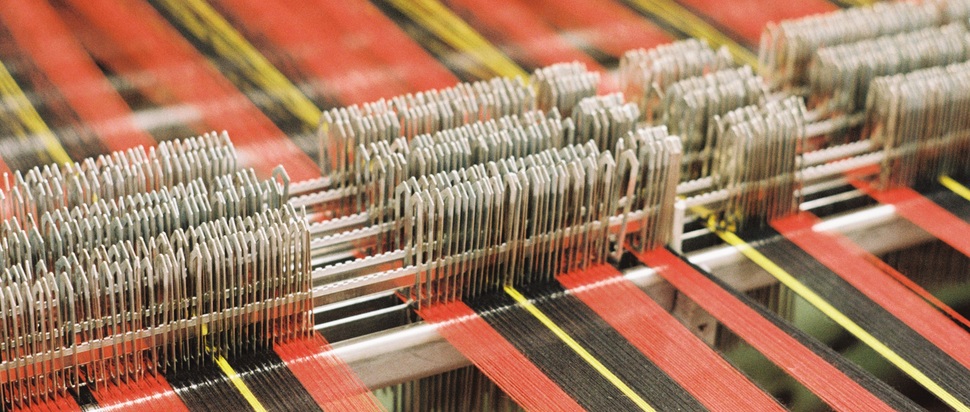Corin Sworn on new film On Weaving
As part of their residency at Alchemy Film and Arts, artists Luke Fowler and Corin Sworn have made On Weaving, a film considering the legacies of textile artists Bernat and Margaret Klein through the lens of their modernist home. Sworn tells us more
“Textiles move in and around things – or, even in making them, you have to move in and around things,” says Glasgow-based artist and filmmaker Corin Sworn. Such spatial dexterity is present within On Weaving, a directorial collaboration between Sworn and Luke Fowler, who are both currently artists in residence at Alchemy Film and Arts. Interweaving past and present, the film, which has its world premiere at the 15th edition of Alchemy Film and Moving Image Festival, responds to the legacies of the late textile artists Bernat and Margaret Klein via High Sunderland, their modernist home in the Scottish Borders. A richly intimate study of labour, gender and migration, On Weaving brings a distinctly grounded yet dreamlike lens to Scottish design.
History is primarily told through prominent figures, and the Kleins’ lives are fairly well-documented, particularly Bernat’s. “But the house has outlasted those people's lives, and yet it's hosted their lives, and now it's hosting new lives,” explains Sworn. As such, she and Fowler were drawn to the Kleins’ home as a focal point from which to disentangle multiple intersecting narratives.
High Sunderland, designed by architect Peter Womersley and completed in 1958, lends itself well to 35mm: clear and coloured glass meets an array of woods, richly accompanied by Klein textiles. Interviews with the current owners, Juliet Kinchin and Paul Stirton – both architecture and design historians – are threaded throughout On Weaving. Certainly, it’s a film bound up with collaborative pairs: Fowler and Sworn; Kinchin and Stirton; Klein and Klein. “We were really lucky because they [Kinchin and Stirton] were so generous and open with us,” says Sworn. Through interviews for On Weaving, Corin and Fowler found that Kinchin and Stirton instinctively connected multiple spaces – and the narratives which run throughout them – together: the house, the landscape, the factories.
The house, Sworn notes, is “porous”. Such permeability threads its way throughout the film in terms of its soundtrack: factory machines – heavy, thudding – are heard over wide shots of the house’s smooth surfaces; softly spoken conversations play over close-ups of the nearby river and the surrounding trees. “We couldn't deny that they are sonically, radically different and even used differently, I think, in terms of what they ask bodies to do inside them, or what they ask materials to do inside them,” says Sworn of the difference between the Kleins’ home and the factory. But, simultaneously, the film rejects spatial dichotomies. The house has its own mechanics – sonically, visually – and the factory has its own domestic concerns. “In moving between the house and the factory, it could too easily look like there are these separate worlds, like there's the home life and then the work life,” Sworn continues. “We wanted to break that down, because that dichotomy has never quite been true, especially around discussions of reproductive or gendered labour.”
The fraught politics of the textile industry weave themselves throughout the film. While women were refused jobs in architecture, they were able to work in textiles. Although this largely women-led work was fairly uncelebrated, it undoubtedly flourished in tandem with architecture. “They were still engaging in the same innovative questioning of what architecture and what design could do for our way of living,” says Sworn. Soft furnishings – curtains, cushions, blankets, rugs – constitute a necessary architecture. “All of these hard surfaces, in the end, are not particularly inhabitable.”
Conceived before the pandemic, the gestation of On Weaving took its time. “During COVID, everyone’s professional lives got turned upside down, which put a lot more space into them,” says Sworn. While raising questions surrounding home working, the pandemic also gave the duo the time to pull together seemingly disparate threads across their respective practices and research interests. Filmed during visits to the house over a year and a half, the 26-minute work rejects a linear chronology. Seasons jump and jut; in this disorientation, Sworn and Fowler delight in an atemporality, which opens up new modes through which to consider history and its spaces. “We’re inhabiting many times at once,” says Sworn.
Certainly, there's a multiplicity of form, narrative and meaning running through On Weaving. “The title refers to the house as a loom and the way that it is able to braid a set of different discussions,” notes Sworn. “And so, in a way, the film uses the house as a form of weaving.” Sworn and Fowler's film shares its title with Anni Albers’ 1965 textiles-based publication, the spine of which features in a momentary close-up. In this, a subtle intertextuality binds On Weaving, and as such, the film is undoubtedly a textile of its own, threading together not too disparate stories and spaces. Indeed, for Sworn, formal similarities bind textiles and cinema. “[Film is] a long celluloid thread that then goes through its own machine and is then projected,” she notes. Consider a film as a textile, a house as a loom; in On Weaving, Sworn and Fowler ask us to consider and reconsider the forms and histories we think we know.
On Weaving has its world premiere at Alchemy Film and Moving Image Festival on 3 May
Alchemy Film and Moving Image Festival takes place in Hawick, 1-4 May. More info at alchemyfilmandarts.org.uk
Filmmography: On Weaving (2025, with Luke Fowler), The Zombie Diaries (2017), The Coat (2015, with Tony Romano), The Foxes (2013), HDHB (2011, with Charlie Prodger), Lens Prism (2010), After School Special (2009), Faktura (2008)
